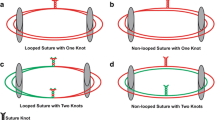Abstract
The integrity of the repair is critical to maintain coaptation of the severed flexor tendon end until healing has advanced sufficiently. In our hospital, we use a modified Savage repair (four-strand Adelaide technique) using 3–0 Ethibond (Ethicon, Somerville, NJ, USA) for acute flexor tenorrhaphy and an active postrepair mobilization protocol. To explain the apparent differences between the theoretical and actual repair strength of a multistrand repair in a single tension test and the reduced strength of a repair subjected to cyclic loading, we compared single and cyclical tensile loading with different suture in vitro configurations of 3–0 Ethibond (Ethicon, Somerville, NJ, USA; one, two, and four strands) and an ex vivo four-strand repair of freshly divided porcine tendon to calculate the ultimate tensile strength (UTS). Mechanical testing was repeated 15 times with both single tensile and cyclical loading for each suture configuration and porcine repair. In the in vitro model, the presence of a knot in a single strand reduced the UTS by 50%. The stiffness of a knotted strand was substantially less than the unknotted strand but became identical after cyclical loading. There was no statistical significance of the UTS between single and cyclical loading with different numbers of strands in this model. In the ex vivo four-strand porcine repair model, there was a significant reduction in UTS with cyclical loading, which equated to the number of strands times the strength of the knotted strand. This discrepancy can be explained by the change in stiffness of the knotted strand after cyclical loading and has important implications for previous studies of suture tendon repair using single tensile loading where the UTS may have been overestimated. We believe that cyclical loading is more representative of physiological loading after acute flexor tendon repair and should be the testing model of choice in suture tenorrhaphy studies.






Similar content being viewed by others
References
Aoki M, Pruitt DL, Kubota H, Mankse PR. Effect of suture knots on tensile strength of repaired flexor tendons. J Hand Surg [Am] 1995;1B:72–5.
Bowyer M, Gelberman RH, Burns ME, et al. Intrasynovial flexor tendon repair. J Bone Jt Surg 2001;83A:891–8.
Elliot D, Moiemen NS, Flemmings AF, et al. The rupture rate of acute flexor tendon repairs mobilized by the controlled active motion regimen. J Hand Surg [Am] 1994;19B:607–12.
Hannafin JA, Arnoczky SP, Hoonjan A, et al. Effect of stress deprivation and cyclic tensile loading on the material and morphologic properties of canine digitorum profundus tendon; an in vitro study. J Orthop Res 1995;13:907–14. doi:10.1002/jor.1100130615.
Kleinert HE, Kutz JE, Atosoy E, Stormo A. Primary repair of flexor tendons. Clin Orthop 1973;4:865–76.
Lister GD, Kleinert HE, Kutz JE, Attasoy E. Primary flexor tendon repair followed by immediate controlled mobilisation. J Hand Surg [Am] 1977;2A:441–51.
Matheson G, Nicklin S, Gianoutsous, et al. Comparison of zone II flexor repairs using an in-vitro linear cyclic testing protocol. Clin Biochem 2005;20:718–22.
Pruitt DL, Manske P, Fink B. Cyclic stress analysis of flexor tendon repair. J Hand Surg [Am] 1991;16A:701–7. doi:10.1016/0363-5023(91)90197-J.
Savage R. In vitro studies of a new method of flexor tendon repair. J Hand Surg [Am] 1995;10B:135–41.
Savage R, Rositano G. Flexor tendon repair using a six strand method of repair and early active mobilisation. J Hand Surg [Am] 1989;14B:396–9.
Shaieb MD, Singer DI. Tensile strengths of various suture techniques. J Hand Surg [Am] 1997;6B:764–7.
Silfverskiold KL, May EJ. Flexor tendon repair in zone II with a new suture technique and an early mobilization program combining passive and active flexion. J Hand Surg [Am] 1994;19A:53–60. doi:10.1016/0363-5023(94)90224-0.
Strickland JW, Glogovac SV. Digital function following flexor tendon repair in zone II: a comparison of immobilization and controlled passive motion techniques. J Hand Surg [Am] 1980;5A:537–43.
Author information
Authors and Affiliations
Corresponding author
About this article
Cite this article
Gibbons, C.E.R., Thompson, D. & Sandow, M.J. Flexor Tenorrhaphy Tensile Strength: Reduction by Cyclic Loading. HAND 4, 113–118 (2009). https://doi.org/10.1007/s11552-008-9151-x
Received:
Accepted:
Published:
Issue Date:
DOI: https://doi.org/10.1007/s11552-008-9151-x




